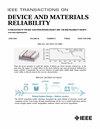Impact of Pulse Voltage Stress on the Reliability of Ferroelectric Thin-Film Transistor
IF 2.3
3区 工程技术
Q2 ENGINEERING, ELECTRICAL & ELECTRONIC
IEEE Transactions on Device and Materials Reliability
Pub Date : 2025-03-05
DOI:10.1109/TDMR.2025.3548038
引用次数: 0
Abstract
Ferroelectric transistors can function as non-volatile memory devices with single-bit, multi-bit, and analog capabilities. State modulation is achieved by programming and erasing with bipolar pulse voltages, while a series of unipolar pulses enable synaptic potentiation and depression. This study examines the effect of pulse voltage stress on the reliability of ferroelectric thin-film transistors (FeTFT) with polycrystalline-silicon (poly-Si) ultra-thin body (UTB) channels. By applying various pulse stresses—bipolar, positive, and negative unipolar—with different pulse widths, we observed distinct degradation behaviors in UTB-FeTFT characteristics. Long bipolar pulse stress caused significant degradation due to the combined effects of the internal electric field from the ferroelectric layer and the external field. In contrast, short bipolar stress led to milder degradation, as lower remnant polarization reduced the total stress field. Rapid changes in electric field direction also limited charge accumulation in the channel, decreasing interface trap generation. Although short bipolar stress had minimal impact on subthreshold swing, it notably degraded maximum transconductance, primarily due to strain in the poly-Si channel’s atomic bonds. Enhancing device reliability is essential for improving FeTFT endurance.脉冲电压应力对铁电薄膜晶体管可靠性的影响
铁电晶体管可以作为具有单比特、多比特和模拟能力的非易失性存储器件。状态调制是通过编程和双极脉冲电压擦除来实现的,而一系列单极脉冲则可以实现突触增强和抑制。本文研究了脉冲电压应力对具有多晶硅(polysi)超薄体(UTB)通道的铁电薄膜晶体管可靠性的影响。通过施加不同脉冲宽度的脉冲应力(双极、正、负单极),我们观察到utb - fet特性的不同退化行为。由于铁电层内部电场和外部电场的共同作用,长双极脉冲应力引起了明显的退化。相比之下,较短的双极应力导致较轻的退化,因为较低的残余极化减小了总应力场。电场方向的快速变化也限制了通道中的电荷积累,减少了界面陷阱的产生。虽然短双极应力对亚阈值摆动的影响很小,但它明显降低了最大跨导,这主要是由于多晶硅通道原子键的应变。提高器件可靠性是提高场效应晶体管寿命的关键。
本文章由计算机程序翻译,如有差异,请以英文原文为准。
求助全文
约1分钟内获得全文
求助全文
来源期刊

IEEE Transactions on Device and Materials Reliability
工程技术-工程:电子与电气
CiteScore
4.80
自引率
5.00%
发文量
71
审稿时长
6-12 weeks
期刊介绍:
The scope of the publication includes, but is not limited to Reliability of: Devices, Materials, Processes, Interfaces, Integrated Microsystems (including MEMS & Sensors), Transistors, Technology (CMOS, BiCMOS, etc.), Integrated Circuits (IC, SSI, MSI, LSI, ULSI, ELSI, etc.), Thin Film Transistor Applications. The measurement and understanding of the reliability of such entities at each phase, from the concept stage through research and development and into manufacturing scale-up, provides the overall database on the reliability of the devices, materials, processes, package and other necessities for the successful introduction of a product to market. This reliability database is the foundation for a quality product, which meets customer expectation. A product so developed has high reliability. High quality will be achieved because product weaknesses will have been found (root cause analysis) and designed out of the final product. This process of ever increasing reliability and quality will result in a superior product. In the end, reliability and quality are not one thing; but in a sense everything, which can be or has to be done to guarantee that the product successfully performs in the field under customer conditions. Our goal is to capture these advances. An additional objective is to focus cross fertilized communication in the state of the art of reliability of electronic materials and devices and provide fundamental understanding of basic phenomena that affect reliability. In addition, the publication is a forum for interdisciplinary studies on reliability. An overall goal is to provide leading edge/state of the art information, which is critically relevant to the creation of reliable products.
 求助内容:
求助内容: 应助结果提醒方式:
应助结果提醒方式:


